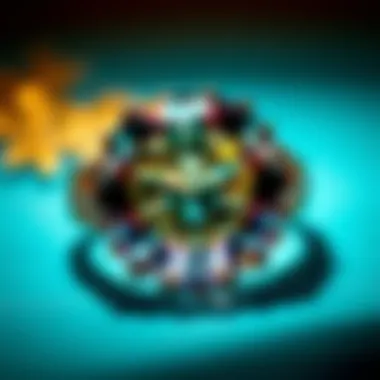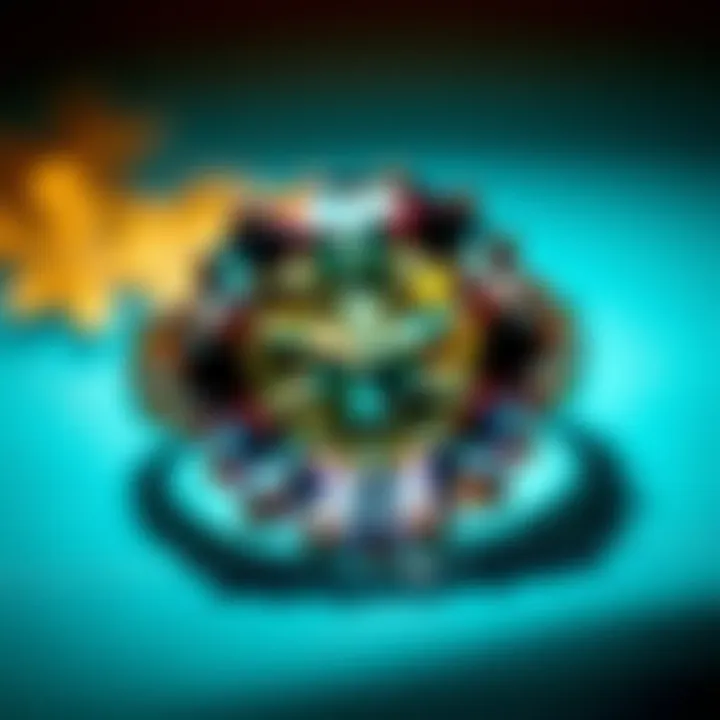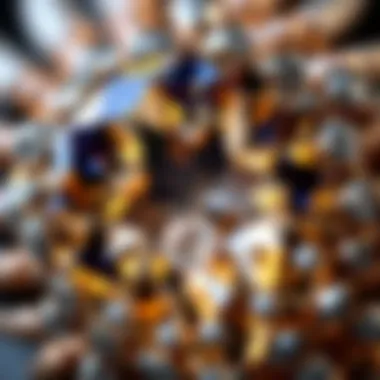Round Cut Gemstones: History, Techniques, and Care


Intro
Round cut gemstones have a story that reaches back through time, carrying layers of significance and craftsmanship rarely found in other stone cuts. These articles of beauty are not just glittering baubles but pieces imbued with historical context, artistry, and practical worth. For gemstone enthusiasts, collectors, and designers, understanding the nuances behind round cut stones can open a treasure trove of insight, enriching their appreciation for these jewels.
Overview of Gemstones and Minerals
Gemstones are nature's artwork shaped into dazzling treasures that have captivated humans since the dawn of civilization. From ancient hieroglyphics to modern jewelry advertisements, gemstones have held sway over human emotion and desire. Their allure is not simply in their beauty but also in their rarity and the stories they carry.
History of Gemstone and Mineral Use
Historically, gemstones have served various roles—from adornments to currency, from talismans to status symbols. In the ancient civilizations of Egypt and Mesopotamia, turquoise and lapis lazuli were worn by royalty and religious figures. Fast forward to the modern era, and you’ll find that round cut diamonds dominate engagement rings, symbolizing commitment and love. Through these examples, we can see how gemstones reflect societal values change over the years.
Significance in Culture and Society
The significance of gemstones transcends mere aesthetic appeal. Often regarded as symbols of protection, prosperity, and health, these stones are woven into the fabric of cultures worldwide. For instance, in India, certain gemstones are believed to enhance specific planetary influences, thus guiding one’s fate. This cultural tapestry adds layers of meaning to round cut gemstones, making them not just purchases but investments into an individual’s identity and beliefs.
Gemstone Formation and Properties
Understanding how gemstones form provides a foundation for appreciating their beauty. Formation is an intricate process often involving heat, pressure, and time.
Formation Process of Gemstones
Gemstones are typically formed deep within the Earth’s crust through geological processes. Take diamonds for instance; they form at extreme pressures at depths of over 100 miles. Over millions of years, volcanic eruptions bring them closer to the surface where they can be mined. This natural artistry is more remarkable than any laboratory-created equivalent.
Properties that Define Gemstones
Several key characteristics define gemstones, influencing their desirability and value:
- Hardness: Measured on the Mohs scale, this determines a gemstone's resistance to scratching. Diamonds, with a score of 10, are the hardest.
- Color: This attribute affects aesthetic appeal and can range widely even within the same gemstone family.
- Luster: Refers to the way light interacts with the surface of the gemstone.
Classification based on Color, Hardness, and Luster
Many gemstones can be classified by their color and hardness. Here’s a quick breakdown:
- Emerald: Green color, moderately hard (score 7.5-8)
- Sapphire: Often blue, but comes in many colors; hard as well.
- Opal: Renowned for its colors and effects, harder to classify due to varying compositions.
These classifications help both jewelers and consumers in making informed choices when selecting gemstones.
Types of Gemstones
While many gemstones fit within the round cut category, it’s essential to understand the broader landscape in which these stones exist.
Precious vs. Semi-Precious Gemstones
Traditionally, gemstones are classified as precious or semi-precious. Precious gemstones include diamonds, sapphires, rubies, and emeralds, while semi-precious stones cover a wider spectrum—amethyst, garnet, and aquamarine, to name a few. This distinction often impacts market price and visibility in jewelry design.
Common Gemstone Varieties
Some of the most popular varieties that often find themselves in round cut forms include:
- Diamonds: Symbol of love and commitment.
- Rubies: Representing passion and vitality.
- Sapphires: Known for both stunning blue hues and astonishing varieties in colors.
Exotic and Rare Gemstones
Exploration into the realm of exotic and rare gemstones can lead you to stunning finds such as Paraiba tourmaline or pink diamonds, which can fetch astronomical prices due to their scarcity. For collectors, these stones encapsulate high value and uniqueness.
Identifying and Evaluating Gemstones
When purchasing gemstones, understanding how to identify and evaluate them is vital.
Factors Affecting Gemstone Value
The value of gemstones can fluctuate based on several factors:
- Rarity: Unique finds fetch higher prices.
- Quality: Cut, clarity, color, and carat weight (the 4 Cs) heavily influence valuation.
- Market Demand: Trends can drive the desire for certain gemstones.
Techniques for Gemstone Identification
Several techniques can help identify and verify gemstones. Tools like gemological microscopes and refractometers provide insights into clarity and index of refraction. Understanding how these tools work can help enthusiasts avoid scams.
Assessing Gemstone Quality
When assessing quality, scrutinize the cut and clarity closely. A well-cut round gemstone maximizes sparkle, while clarity can be a deal-breaker, especially in more expensive stones like diamonds.
Caring for Gemstones


Owning gemstones is not just about the purchase; it's also about maintenance and care.
Cleaning and Storing Gemstones Properly
Regular cleaning preserves the luster of gemstones. Use a soft cloth and mild soap for cleaning. Proper storage in soft pouches or separate compartments is advisable to prevent scratches.
Avoiding Common Mistakes in Gemstone Care
It's a common misconception that all gemstones can be cleaned in the same way. For instance, certain stones like opals may require specialized care.
Preservation Tips for Specific Gem Types
Here are some preservation tips for commonly owned stones:
- Diamonds: Regular cleaning is beneficial, avoiding harsh chemicals.
- Emeralds: Avoid exposure to extreme heat; they can easily crack.
By understanding gemstone care, collectors can maintain their treasures in pristine condition, ensuring they remain as alluring as the day they were acquired.
Prelims to Round Cut Gemstones
Round cut gemstones hold a special place in the jewelry world, not just for their stunning visual appeal but also for their deep-rooted history. These gems exemplify a blend of artistic craftsmanship and scientific precision. Their popularity can be attributed to an intricate balance of aesthetic qualities, durability, and brilliance, setting them apart in the vast array of gemstone cuts available today.
Understanding round cut gemstones is crucial for enthusiasts and collectors alike. They often serve as the benchmark against which other cuts are measured. When purchasing jewelry, recognizing the nuances of what makes a round cut exceptional can sway decisions in favor of pieces that may not just dazzle the eye but also hold significant value.
Defining the Round Cut
So, what exactly defines a round cut? This term refers to gemstones shaped into a circle, typically possessing 58 facets designed to maximize brilliance. The round brilliant cut is the most recognized variant, perfected to enhance the refractive qualities of the stone. Light enters the gem, bounces off these facets, and returns to the viewer's eye in a stunning display of color and brilliance.
The ideal proportions of a round cut gemstone are more than a guideline; they represent generations of cutting expertise refined through experimentation and practice. A well-executed round cut will exhibit exceptional light performance, making it a favored choice for engagement rings and other meaningful jewelry pieces.
Historical Evolution of the Round Cut
The evolution of the round cut is as fascinating as the gems themselves. It all began in the late 14th century when the earliest known diamond cut was created. However, during that time, round cuts were crude, lacking the precision of modern techniques. Fast forward to the late 19th century, when a jeweler named Marcel Tolkowsky introduced a mathematically calculated round brilliant cut. His innovations set standards based on proportions that resulted in maximum light reflection.
This breakthrough fundamentally reshaped the industry. Round cut gemstones not only became more appealing but also more widely recognized as a symbol of elegance and status. Today, they are integral to various cultural associations and symbolism surrounding love and commitment, especially in engagement rings.
"The round cut has become synonymous with timeless beauty and enduring value, enduring through trends and styles for centuries."
Every window into the history of round cut gemstones reveals a story of innovation but also of changing tastes and societal norms. Understanding this historical context not only enhances our appreciation of these gems but also informs us of their significance in contemporary jewelry making. The enduring allure of round cuts signifies their role as both a representation of personal milestones and the intricate art of gemology.
The Cutting Process
The process of cutting gemstones is pivotal in defining their beauty and value. This complex art merges technical precision with an artist's touch, ultimately transforming an unrefined rock into a breathtaking piece of jewelry. Each cut can significantly influence how light interacts with the gem, affecting its brilliance, fire, and overall appearance, which is especially crucial for the round cut. The round cut, renowned for its ability to maximize light reflection, serves as a benchmark in gemstone quality, setting a standard that other cuts strive to emulate.
Understanding the Art of Gem Cutting
Gem cutting, often regarded as a meticulous craft, requires a deep understanding of materials, techniques, and the visual impact of shapes. Experienced gem cutters, or lapidaries, devote years honing their skills. They analyze each stone’s unique attributes, such as size, color, and clarity, before deciding on the optimal cut. This decision-making process is vital, as each facet of a round cut gem is designed to enhance luminosity while maintaining the integrity of the stone.
From the initial block of rough gemstone to the finished product, every step involves careful consideration. For example, a round diamond cut follows a specific set of proportions to achieve the ideal balance between brilliance and durability. The result is a gem that not only sparkles but stands the test of time, immensely appreciated by collectors and enthusiasts alike.
Tools and Techniques Used
The tools of the trade in gemstone cutting are quite specialized, with a variety of instruments utilized based on the gem in question. Key tools include:
- Diamond saws: Essential for cutting rough stones with precision.
- Grinding wheels: Used for shaping the gem and creating the facets necessary for light reflection.
- Polishing wheels: These ensure a smooth finish, bringing out the brilliance in the stone.
In addition to traditional tools, modern technology has introduced laser cutting machines. These machines offer high precision and can create intricate designs that are impossible to achieve manually. However, many gem cutters still prefer the traditional methods, believing that the art of cutting is best expressed through hands-on techniques.
Factors Influencing Cut Quality
Several elements can impact the quality of a gemstone cut. First and foremost is skill level—a seasoned cutter will know how to navigate the inherent challenges of different types of stones. Furthermore, the quality of the original rough gem plays a significant role; inclusions can pose challenges and require skilled decisions to ensure the final product maximizes aesthetic appeal without compromising structural integrity.
Other considerations include:
- Proportions: The ideal dimensions of a round cut can influence how light enters and exits the gemstone;
- Symmetry: Flawless symmetry ensures even light reflection, crucial to creating the desired sparkle;
- Polish Quality: A well-polished surface enhances light return and minimizes light loss.
The cut quality not only affects the beauty of the gemstone but also influences its market value. A well-cut gem can command a significantly higher price than a poorly cut one, even if they share the same carat weight and color.
Thus, understanding the intricacies of the cutting process underscores the importance of artistry and technique in crafting stunning round cut gemstones. Gem enthusiasts often appreciate this effort, discovering that the allure of a gemstone is as much about the way it is crafted as it is about the stone itself.
Visual and Physical Properties
Understanding the visual and physical properties of round cut gemstones is crucial for both the aesthetic appeal and functional integrity of these stones. When discussing gemstones, one might often hear terms like brilliance, symmetry, and durability thrown around. Each of these aspects plays a significant role in determining the overall charm, value, and durability of a round-cut gem. Thus, familiarity with these characteristics will serve gemstone enthusiasts and collectors well, helping them make informed decisions.
Brilliance and Fire in Round Cuts
Brilliance, in the context of gemstones, refers to the light that reflects off the surface and disperses within the stone itself. Round cut gemstones, especially diamonds, excel in brilliance. This is primarily due to the precise geometry of the cut. When light enters the stone through the table (the flat top), it is refracted through the facets, creating a dazzling display that captures the eye.


Fire refers to the scattering of light into its spectral colors. The round cut's ability to produce a vibrant rainbow of colors contributes to its attractiveness. In a well-crafted round diamond, the two traits—brilliance and fire—create a mesmerizing effect that many find irresistible. As the gem is rotated, it plays with light, creating varying patterns of brilliance and bursts of color visible to the viewer.
To truly appreciate the brilliance and fire in round cut gemstones, it’s essential to examine them under different lighting conditions. For example, viewing a diamond under direct sunlight may reveal its full sparkling potential, while softer indoor lighting can emphasize its warmth and color.
Symmetry and Proportions
Symmetry refers to the evenness in the arrangement of facets on the gemstone, while proportions relate directly to the depths and angles at which these facets are cut. For round cut stones, symmetry and proportions are pivotal for achieving maximum brilliance and fire. Think of it like baking a cake; if all the ingredients are balanced and measured properly, the end result will be delightful. But if it’s too dry or unevenly baked, well, you might not be serving that at a dinner party.
A perfectly cut round gem typically has 58 facets, arranged in precise ratios. For instance, if the table is too large or too small compared to the overall size of the diamond, it can adversely affect how light interacts with it, dimming its sparkle. Many grading systems, such as those used by the Gemological Institute of America (GIA), assess symmetry and proportions closely. They classify stones, giving potential buyers a comprehensive idea of what they’re choosing.
The importance of symmetry can't be overstated. Irregularities in facet placement or size can distract the eye, making even the finest gemstones lose their allure. Thus, it’s high time that collectors pay close attention to symmetry to ensure they’re investing in the best possible stone.
Durability and Hardness Ratings
Durability in gemstones is paramount, especially when it comes to jewelry that will be worn daily (like engagement rings). Hardness, measured on the Mohs scale, describes a gemstone's ability to resist scratching. Diamonds reign supreme here, scoring a 10, making them ideal for prolonged wear. However, several other gemstones can be transformed into stunning round cuts as well, including sapphires and rubies, which score around 9 on the Mohs scale.
Despite their brilliance, round cut gemstones aren’t invincible. Although diamonds are the hardest, they can still chip or fracture if subjected to harsh impact. Therefore, proper care and knowledge of how to handle these stones are essential for maintaining their beauty over time.
Popular Gemstones for Round Cuts
The allure of round cut gemstones is not merely defined by their shape but also by the intricate processes and considerations behind their selection. Each gemstone brings its own story and significance to the table, contributing to a larger narrative in the world of jewelry. Understanding the various gemstones suitable for round cuts allows enthusiasts and collectors to appreciate their unique qualities and the roles they play in ornamentation. From the glitter of diamonds to the vibrant hues of colored gemstones, this section will explore the appealing attributes of popular choices, making the prospect of owning such pieces all the more appealing.
Diamonds: The Benchmark
Diamonds have often been hailed as the gold standard in gemstones, particularly when it comes to round cuts. Their unmatched brilliance and hardness make them a perennial favorite for engagement rings and high-end jewelry alike. The round brilliant cut, developed in the early 20th century, is specifically designed to maximize the gem's light performance, creating that captivating sparkle that diamonds are famous for.
- Clarity: Diamonds are valued for their clarity, which refers to the absence of internal inclusions or external blemishes. A higher clarity grade permits more light to pass through the gem, enhancing its brilliance.
- Color: While most people associate diamonds with clear, colorless stones, they also come in a variety of hues, such as pink, blue, and yellow. These colored diamonds can offer a unique and trendy twist on classic pieces.
- Cut: The quality of the cut is paramount in determining a diamond’s overall appearance. Optimal proportions enhance reflections and refractions, resulting in breathtaking sparkle.
"A well-cut diamond is a marvel; it reflects not just light but also the emotions of those who choose it."
Colored Gemstones: Options Beyond Diamonds
For those looking beyond the traditional choices, colored gemstones offer a dazzling array of options. Round cuts can present a rich tapestry of colors, each with its own set of characteristics. Sapphires, rubies, and emeralds are just a few examples that stand out in a round cut, reminding us that variety is the spice of life.
- Sapphire: Known for its deep blue tones, sapphires can also appear in shades of yellow, pink, and even green. Their durability makes them an excellent choice for everyday wear.
- Ruby: With its vivid red hue, rubies symbolize love and passion. The captivating allure of a round cut ruby can serve as a stunning centerpiece in any piece of jewelry.
- Emerald: Renowned for its lush green color, emeralds invite fascination with their inclusions, often seen as part of their charm. A round cut emerald can lend a touch of sophistication and nature's beauty.
Synthetic vs Natural Round Cut Gemstones
In recent years, the debate between synthetic and natural gemstones has garnered significant attention. With advancements in technology, synthetic gemstones are becoming indistinguishable from their natural counterparts, presenting ethical and economic considerations for consumers.
- Natural Gemstones: These are formed in the Earth over thousands to millions of years, bearing the unique marks of their origins. Collectors often prefer natural stones for their rarity and the story they carry.
- Synthetic Gemstones: Created in controlled environments, synthetic gemstones can replicate the physical and chemical properties of their natural counterparts at a fraction of the cost. They can offer brilliant options for those who might be on a tighter budget or seeking specific attributes without the hefty price tag.
Evaluation and Grading
Evaluating and grading round cut gemstones is integral to understanding their true worth in the gem market. Unlike other items where aesthetic appeal might prevail, gemstones such as diamonds and sapphires need serious scrutiny on multiple fronts. Correctly gauging their value can save buyers from heartache down the road. This section distills the core components essential for accurate evaluation, guiding potential buyers, sellers, and collectors alike.
An informed evaluation incorporates the Four Cs of gemstone assessment, namely Carat, Cut, Color, and Clarity. Each of these elements serves a unique purpose in determining the gemstone's worth and desirability.
The Four Cs of Gemstone Evaluation
- Carat: This refers to the weight of the gemstone. A higher carat implies a more significant stone, typically fetching a higher market value. However, this isn't strictly linear, as rarity and demand for certain colored gems can skew perceptions of worth.
- Cut: This encompasses not just the shape but also the quality of the facets and how they interact with light. A well-cut stone enhances brilliance, while a poorly cut one can dim its overall appeal. Remember, when it comes to round cuts, excellent symmetry is vital in maximizing sparkle.
- Color: Gemstone color can vary widely and significantly affects their market value. For diamonds, grades range from D (colorless) to Z (light yellow or brown), while colored stones have unique classifications based on hue, saturation, and tone. Collectors often have soft spots for vivid colors, so understanding what shades are in vogue can be a savvy move.
- Clarity: This assesses the presence of inclusions or blemishes. Inclusions are internal, while blemishes are external. Stones with fewer flaws typically have a better grade. However, certain inclusions can enhance uniqueness—such as the garden-like inclusions found in some tourmalines that can even increase desirability.
Knowing these Four Cs allows enthusiasts and professionals alike to make informed decisions when purchasing gemstones, ensuring they get their money's worth.
Certification Standards and Agencies
Gemstone certification plays a pivotal role in the credibility of a gem’s evaluation. Certification engenders trust between gem dealers and buyers, providing a documented assurance of quality. Several reputed bodies offer certification, each with its own set of standards, ensuring consistency in evaluation. Noteworthy organizations include the Gemological Institute of America (GIA) and the International Gemological Institute (IGI).
Certifications generally breakdown these evaluations through detailed reports. These feature important specifics like the Four Cs, along with additional notes concerning treatments or enhancements that may not be visible to the naked eye.
"A certified gemstone often commands a higher price in the market due to the quality assurance the certification guarantees."
Here are some reputable certifying organizations:
- GIA: Renowned globally for its rigorous educational programs and grading systems, especially for diamonds.
- IGI: Focused on both diamonds and colored gems, providing clear and straightforward grading reports.
- AGS: Offers a unique cut grade system, known for its specific criteria on diamond cut excellence.
- EGL: While it has faced some criticism for variability in standards, it still plays a role in the larger landscape of gemstone grading.
In summary, whether you're diving into a marketplace as a buyer or a seller, understanding these grading metrics and the significance of certification can be the difference between a valuable investment and a regrettable purchase.
Caring for Round Cut Gemstones
Caring for round cut gemstones is essential for both their appearance and longevity. These gems can be a significant investment, and maintaining their beauty over time is crucial. Proper care not only helps to preserve their brilliance but also ensures that they remain a source of enjoyment. When you own a round cut gemstone, it becomes part of your lifestyle, and understanding how to care for it is key to protecting your treasure from the elements.
Best Practices for Maintenance
When it comes to keeping your round cut gemstones in tip-top shape, you can follow several best practices. These techniques can seem simple but yield significant benefits:
- Regular Cleaning: Use a soft cloth dampened with warm water to clean your gemstones regularly. Avoid harsh chemicals that can dull the shine.
- Ultrasonic Cleaners: If you own a more complicated setting, use ultrasonic cleaners with caution. These devices can do wonders for deep cleaning, but ensure your gemstone can withstand the process first.
- Avoid Exposure: Keep your gemstones away from extreme temperatures and direct sunlight, as prolonged exposure can affect color and integrity.
- Store Wisely: Use a velvet-lined jewelry box or a separate pouch for each piece. This helps prevent scratching among your collection.
- Routine Inspections: Regularly check for loose settings or damage. A stone that’s come loose can be lost if not caught early.


By maintaining your gemstones through these practices, you can assure their sparkle and continue to enjoy them for years.
Common Pitfalls to Avoid
While owning round cut gemstones can be a joy, it's easy to slip into some common pitfalls that might dull their shine. Here are key mistakes to watch out for:
- Neglecting Cleaning: Over time, dirt and oils can accumulate, dimming the stone's brilliance. When you notice a less vibrant look, it's time for a cleaning session.
- Using Harsh Chemicals: Never use bleach, ammonia, or any abrasive cleaners. Such substances can lead to irreversible damage.
- Improper Storage: Storing your gemstones in a mixed jewelry box can lead to scratches. Always give them space to shine alone.
- Ignoring the Setting: Sometimes, the setting can become tarnished or damaged. Regularly check the prongs if you have a round cut diamond, for instance.
"An ounce of prevention is worth a pound of cure." Consistent care means your round cut gemstones remain as stunning as the day you first laid eyes on them.
Implementing these best practices and avoiding common pitfalls will extend the life and beauty of your round cut gemstones. Your careful attention can transform a simple piece of jewelry into a cherished heirloom.
Market Trends and Economic Factors
The market landscape for gemstones has evolved significantly over the years. Understanding market trends and economic factors is not just for investors; it’s crucial for collectors and jewelry designers alike. These elements help in making informed decisions on purchases and selling, ensuring one maximizes both aesthetic and monetary value. In this section, we will explore current valuation trends as well as the supply and demand dynamics that influence the realm of round cut gemstones.
Current Market Valuation Trends
In today’s market, valuation trends for round cut gemstones often reflect broader economic conditions. For instance, inflation can cause fluctuations in gemstone prices as luxury goods often see a rise in demand during economic stability. According to recent reports from the Gemological Institute of America (GIA), round diamonds specifically have maintained a strong market presence, with consistent increases in value over the past decade.
There are key drivers influencing prices:
- Quality of the Stone: Factors like color, clarity, cut, and carat weight weigh heavily on valuation. High-quality round cuts tend to appreciate faster.
- Market Demand: Increased interest in custom jewelry designs has seen the demand for round cuts soar; they pair well in various settings, from solitaire rings to elaborate necklaces.
- Cultural Shifts: As more people seek unique engagement rings beyond traditional diamonds, the market for colored round cut gemstones has also expanded. Sapphires and rubies, for example, have found their footing alongside diamonds in modern jewelry.
As such, it’s no surprise that buyers are increasingly seeking expert appraisals to ensure they are getting fair value for their investments.
The Impact of Supply and Demand
Just like any other commodity, the prices of round cut gemstones are heavily influenced by supply and demand. A key consideration here is that certain stones are limited, while others might flood the market based on mining practices and preservation of resources.
When demand spikes, but supply remains constant, prices can soar. This is evident with diamonds, where limited new mines and increased demand for engagement jewelry push prices upward. On the flip side, if a new deposit of gemstones is discovered or if synthetic alternatives become more prevalent, the market can shift quickly.
Some factors to watch in the supply-and-demand equation include:
- Mining Output: Geopolitical situations in mining countries can drastically affect the supply chain. For example, if a country goes through social or political turmoil, mining may halt, leading to reduced availability of gemstones.
- Technological Advances: Innovations in gemstone creation, particularly synthetic varieties, offer cheaper alternatives and may influence demand for natural stones.
- Consumer Preferences: The taste of consumers can change. For example, a trend favoring unique stones over classics can reduce demand for traditional round diamonds, shifting focus toward other options like round cut blue sapphires.
"The desirability of gemstones can be as fleeting as the wind, often changing based on prevailing societal trends and values."
Ultimately, staying in tune with these market dynamics can empower gemstone enthusiasts and professionals alike to navigate their investments wisely. Whether evaluating current trends or anticipating shifts in supply, understanding these factors is paramount in making well-informed choices in the beautiful world of round cut gemstones.
Relevant Links:
- Gemological Institute of America
- Wikipedia on Gemstone
- Reddit Community for Gemstone Discussions
- National Jeweler Business Report
Round Cut Gemstones in Jewelry Design
When talking about round cut gemstones in jewelry, it's hard to overstate their significance. The round cut is like the bread and butter in the world of gem cutting, a classic choice that exudes timeless elegance and versatility. From engagement rings to pendants, these gems hold a space that is both cherished and straightforward, appealing to a range of styles and preferences. What sets round cut gemstones apart in design terms? Let’s unravel some specifics.
Design Aesthetics and Innovations
Round cut gemstones shine not only for what they are but for the creativity they inspire in jewelry design. Their perfectly symmetrical shape acts as a canvas for designers, allowing them to explore a myriad of settings and styles.
- Versatile Styles: Whether it's a solitaire setting that speaks of simplicity or a halo design that aims to dazzle, round cuts adapt effortlessly across various styles. Their proportions contribute to an eye-catching brilliance, making them a favorite among designers.
- Innovative Techniques: With advancements in technology, jewelers are constantly innovating settings that enhance the beauty of round cut gemstones. Techniques like bezel setting or pavé settings help maximize sparkle while maintaining safety. Today’s modern approaches might even feature unconventional materials like alternative metals or mixed materials, breathing new life into the traditional.
- Color and Combination: The flexibility of round cuts allows for experimenting with color combinations. Take a round cut sapphire nestled in a band of diamonds, for instance; this kind of pairing not only elevates the gemstone’s natural hue but also adds depth, creating striking contrasts.
"Round cut gemstones serve as the backbone of jewelry design, showcasing brilliance while encouraging design innovation."
The Role of Round Cuts in Modern Jewelry
In the contemporary jewelry scene, round cut gemstones are still front and center, but with a twist. Fashion and function harmonize in a ballet of brilliance, appealing to both the practical and the aesthetic senses. Here’s how they fit into today’s jewelry landscape:
- Everyday Elegance: Round cuts are not just reserved for special occasions. Their shining allure lends itself to everyday wear as well, making them adaptable for casual outings and formal events alike. Think of a simple stud earring or a delicate pendant—pieces that wear well day after day.
- Sustainable Choices: Many modern consumers are leaning toward sustainable practices, and round cut gemstones are no exception. With an increasing number of ethical sources for both natural and synthetic stones, designers can create beautiful pieces while prioritizing sustainability.
- Personalization Trends: More than just stones, round cuts are often personalized, embedding them with stories and memories. Names, birthstones, or even significant dates can be represented through these gems, making the jewelry not just an accessory but a cherished keepsake.
- Bridging Generations: There's also a nostalgic aspect to round cut gemstones; they resonate through generations. Often passed down from mothers to daughters, these pieces maintain emotional value while staying stylish.
Each facet, each reflection of light, carries stories of the past while inviting new narratives in the present. Round cut gemstones, with their unique standing in jewelry design, reflect the dynamic nature of art and self-expression.
End
In summarizing the exploration of round cut gemstones, we realize their significance goes well beyond mere aesthetics. Round cut stones have a rich history intertwined with craftsmanship and artistry, dating back centuries. Their unique characteristics not only captivate the eye but also hold immense value in the world of jewelry.
Final Thoughts on Round Cut Gemstones
Round cut gemstones exemplify the delicate balance between technical prowess and natural beauty. Their symmetrical nature creates a visual harmony that attracts many. Various gemstones, such as diamonds, sapphires, and emeralds, assume a new life when expertly cut into a round shape. Collectors and enthusiasts recognize that these cuts maximize brilliance and enhance color play, a feature particularly appealing in colored gemstones. Moreover, they often serve as a benchmark against which other cuts are evaluated, showcasing how the principles of light reflection and refraction can elevate their status in both fashion and investment.
"A gemstone's cut is not just a matter of shape; it's about the soul it reveals."
They are often perceived as versatile and classic choices, ensuring round cuts remain a staple in modern jewelry design. The versatility extends into various settings, from engagement rings to statement pieces, proving that their appeal transcends fleeting trends.
Future Perspectives on Gemstone Cutting
The landscape of gemstone cutting continues to evolve with advances in technology and a greater understanding of material properties. Notably, laser cutting and computer-aided design (CAD) are reshaping how gemstones are crafted. This shift allows for precision that was once thought impossible, and it opens the door for innovative designs that blend traditional artistry with modern techniques.
As consumers become increasingly aware of ethical sourcing and environmental impacts, future perspectives also align with sustainability. Synthetic stones are gaining traction, with methods improving in how they mimic the beauty of natural gemstones. This trend prompts a reevaluation of values in the gemstone market.
Looking ahead, gemology as a field may embrace even more interdisciplinary influences—from art to advanced materials science. As a consequence, the round cut might not just remain a favorite, but also an area of exploration for new types of gems and cutting styles, ensuring that centuries down the line, these beloved gemstones retain their allure.







